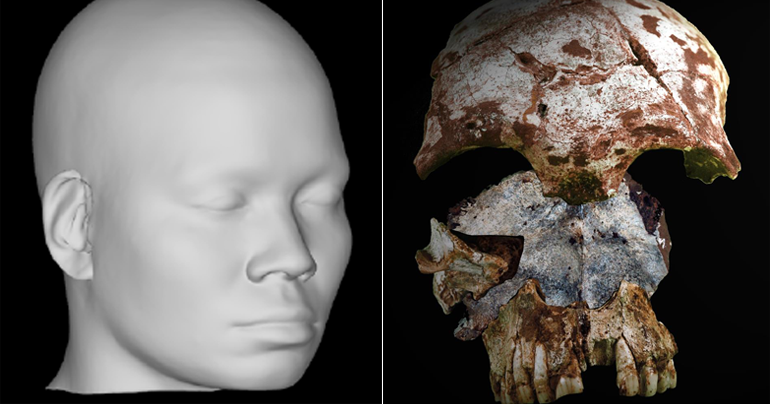It was like being in a science fiction movie. As the team of scientists and their assistants climbed up through the green mountain jungle and entered a huge cave, an eerie yellow-white light illuminated a corner at the far end of the cave. Large bright aluminium boards reflected the light. Hanging down from the ceiling and into a trench was a network of thin, numbered strings. But this wasn’t a glimpse into the future – it was scientific staging for a journey 80,000 years back into prehistory.
The limestone karst hill of Pà Hang in northeastern Laos is a treasure trove of human, environmental and faunal history covering almost 100 millennia. Like most karstic areas, Pà Hang is home to many caves like Tam Pà Ling, the one scientists are examining to discover what is hidden in its red sediments.
Palaeoanthropologist Dr Fabrice Demeter from Musée de l’Homme in Paris explained: “We have found remains from seven modern humans (Homo sapiens) dating from 50,000 to 80,000 years ago. They represent the oldest modern humans found in mainland Southeast Asia so far. In our site, we have excavated two different kinds of populations: one fully modern population with an anatomy like us today and another population which has a mixture of modern and archaic features which means that this population is more related to archaic fossils found in northern Africa and Israel. We think that this area in Laos had a high diversity of humans, with at least these two different populations living at the same place at the same time – and both being Homo sapiens.”

Demeter is leader of the expeditions, which, since 2003, have excavated both the caves and the plain in front of Pà Hang hill. In the November-December 2018 field season, the scientists hit hard rock at the bottom of the 7m trench in Tam Pà Ling, hindering deeper digging and forcing the scientists to extend the excavation outwards from the cave walls. The overlying metres of sediments have yielded fossils from seven ancient individuals – from skulls, mandibles and fragment of a tibia to one of this year’s highlights: another tibia fragment that could connect to the one the anthropologists found last year.
On the question of resemblance between present-day people in this part of the world and the prehistoric people from the excavation, Demeter is cautious: “Based on fossils from one of the humans, we have reconstructed a head in a computer modelling programme – but it is hard to say if there is any resemblance.”
Life then and now
It might be difficult to compare past with present human facial features based solely on fragmentary bones. But when the talk is on comparing past environments and animal life with the present, the scientists are on more steady ground. Excavations at Tam Pà Ling and other sites in and around the Pà Hang hill have shown to be rich in animal fossils, so reconstructing climate, landscape and fauna has been done in detail. Dr Anne-Marie Bacon from the Centre National de la Recherche Scientifique (CNRS) at the University Paris Descartes has also been involved in the Pà Hang excavations since 2003.

As she spread part of her 2018 collection of sampled teeth on a piece of cardboard, she explained: “From these animal teeth and from the human fossils, we are trying to reconstruct both the climate and the environment around here and hypothesise the relations like hunting between humans and animals. During the time range studied, in the last 150,000 years and until [around] 12,000 years ago, warm periods have been followed by cooler periods. In the northern hemisphere, large areas were covered by ice during the latest ice age. Not so here in Southeast Asia. During the glacial period, mainland Southeast Asia only saw a drop in temperature of maybe 4 to 5 °C, which is not enough to change the vegetation and the fauna dramatically. The area was still within the tropics and subtropics and the habitat remained predominantly forested with dense tree canopies, low light and small parts of open areas and savannah.”
This contrasts with the landscape today, which is composed of mixed open and closed forest but no canopy forest. With such a continuity, one might expect that animal life wouldn’t have changed much during the preceding millennia. Both yes and no. Dr Bacon explained: “Animals such as tiger, leopard and rhino are still around in the region. Other species like the panda and the orangutan have another distribution today – the panda went extinct in Southeast Asia around 20,000 years ago and is only living in China’s Yunnan province, and the orangutan can now only be found in Sumatra and Borneo. Yet other animals have gone extinct, like the giant tapir and an archaic elephant species called stegodon.”
Causes of these extinctions are contested among scientists. They may be climate change, human competition or both. Dr Bacon gave an example: “Around 15,000 years ago, the spotted hyena disappeared from Southeast Asia. As both the hyena and the humans hunted the same animals for food, humans could have been more successful and outcompeted the hyena to extinction.”
The digging in the caves and on the ground in front of Pà Hang continues. Along with the tibia fragment found in Tam Pà Ling, another highlight of this field season was the finding in a neighbouring cave of the tooth of an early hominin – a long extinct relative of the Homo sapiens family. With each new discovery scientists are able to learn more about this era and the people who roamed these mountains thousands upon thousands of years ago, giving us all a snapshot of our own prehistory.


